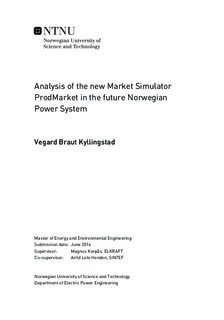| dc.contributor.advisor | Korpås, Magnus | |
| dc.contributor.advisor | Henden, Arild Lote | |
| dc.contributor.author | Kyllingstad, Vegard Braut | |
| dc.date.created | 2016-06-24 | |
| dc.date.issued | 2016 | |
| dc.identifier | ntnudaim:15340 | |
| dc.identifier.uri | http://hdl.handle.net/11250/2404696 | |
| dc.description.abstract | The main objective of this thesis has been to verify ProdMarket as a software tool. Three simulation cases is created to perform a future scenario analysis assessing ProdMarket s robustness and future potential. Overall, ProdMarket shows unsatisfactory economic results for systems with high penetration of intermittent power generation. Simulations are performed on a small-scale model of the Norwegian power system. A simplified implementation of continental transfer capacity is used to explore the impacts of increased cross-county interconnectivity. Balancing of intermittent power is of particular interest. Results have been compared to a second scheduling software, EMPS.
Facing increased integration and complexity, system operators and market participants are continually in need of better decision support tools to aid them in their search for effective operation and planning. ProdMarket is a state-of-the-art SINTEF-developed prototype in this search for efficiency. It uses stochastic dual-dynamic programming (SDDP) to simulate hydropower systems in great detail.
For the most part, results seem reasonable. ProdMarket shows superior utilization of the balancing capacity of conventional and pumped hydro power plants, leading to smaller short-term price oscillations. Results for the simulation case representing the present Norwegian system is very good. But ProdMarket shows unacceptably poor economic results relative to EMPS as parameters are changed in the two future scenarios.
Previous work with ProdMarket has shown good results when intermittent power is placed on the local level; poor results are now seen as intermittency is increased on the global level. The price model handles interaction between the local and global simulation modules in ProdMarket it is suggested as a contributor to the poor economic results. The most obvious flaw in the results is that ProdMarket stores excessive amounts of water in hydropower magazines towards the end of the simulation period. This is attributed to weaknesses in using EOPS for internal end-of-period water valuation. End valuation is considered a second contributing factor to weak economic results in the future simulation cases.
Assessing the economic loss suffered as a results of each of the two problem factors presented is challenging. As a consequence, there is a great deal of uncertainty related to ProdMarket s future potential. Considerable improvements will have to be made on the model s robustness in order for ProdMarket to become a serious alternative to models such as the EMPS. | |
| dc.language | eng | |
| dc.publisher | NTNU | |
| dc.subject | Energi og miljø, Energianalyse og planlegging | |
| dc.title | Analysis of the new Market Simulator ProdMarket in the future Norwegian Power System | |
| dc.type | Master thesis | |

